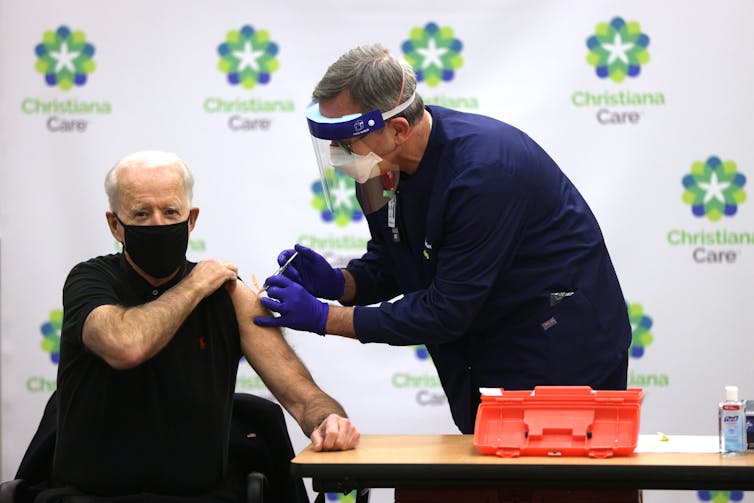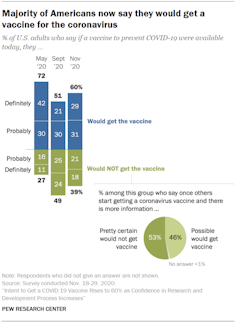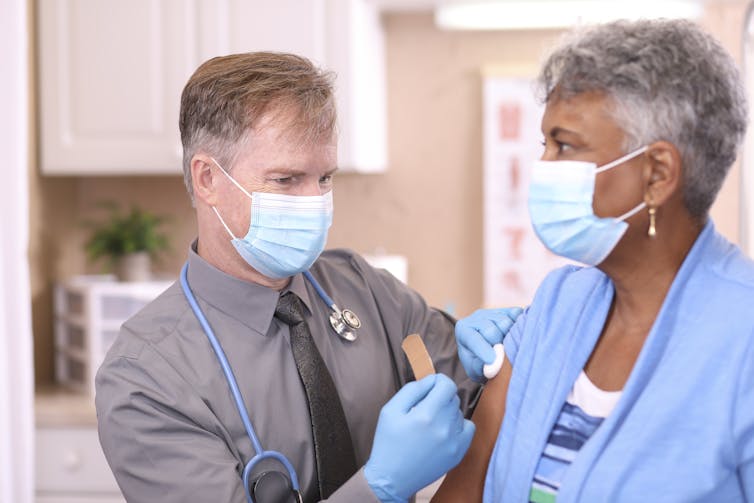Americans have unrealistic expectations for a COVID-19 vaccine
Many Americans appear to be experiencing cautious optimism about the role that vaccines could play in ending the pandemic. But recent public opinion research suggests that 29% to 37% of Americans plan to refuse a COVID-19 vaccine.
According to some epidemiological estimates, as many as three-fourths of Americans must become immune to COVID-19 – either by recovering from the disease or by getting vaccinated – to halt the virus’s spread. As a scholar who studies vaccine hesitancy, I ask how Americans’ vaccine-related expectations might influence their willingness to vaccinate. What attributes do Americans expect a COVID-19 vaccine to have, and will they be less likely to get vaccinated if the vaccine they have the opportunity to take defies some of their preferences?
In a new peer-reviewed study, I found that the vaccine Americans most prefer may not reflect the choices we actually have. Americans are most likely to intend to vaccinate when a vaccine is made in the U.S., administered in a single dose, over 90% effective and carrying a less than 1 in 100 chance of experiencing minor side effects, and has spent just over a year in development.
However, even under these ideal conditions, the likelihood that the average respondent in the study would choose to vaccinate is just 68%. This implies that many Americans may refuse vaccination, even when a vaccine satisfies their expectations.
How The Conversation is different: We explain without oversimplifying.

Why do some Americans plan to refuse a COVID-19 vaccine?
Since Pfizer and Moderna vaccines gained emergency use authorization, front-line health care workers and other vulnerable groups have started to receive the vaccine.
Public opinion research, however, has documented substantial COVID-19 vaccine hesitancy. While intentions to vaccinate have rebounded in recent weeks following a substantial drop-off this past summer, some recent estimates suggest that more than a third of Americans plan to forgo vaccination. Refusal rates that high could jeopardize our ability to achieve population immunity, and thereby prolong the pandemic.

Consequently, many researchers have tried to figure out why some Americans are more likely to refuse a vaccine than others. Both academic and public opinion research finds that women, compared with men, and Black Americans, compared with white Americans, are significantly more likely to intend to refuse vaccination.
Vaccine refusal is also politically contentious. Refusal tends to reflect disagreements with the way politicians talk about vaccine-related issues.
Fewer studies, however, have asked about whether or not the properties of vaccines themselves might influence vaccination intentions.

Do Americans prefer some COVID-19 vaccines to others?
My new peer-reviewed study, based on a representative online survey of U.S. adults, offers some answers. I asked 990 U.S. adults to each rate how likely they would be, on a scale of 1 to 10, to pursue vaccination for vaccines with randomly chosen attribute combinations.
Respondents rated their intentions to vaccinate for hypothetical vaccines that varied in their countries of origin (U.S., U.K., China, or Russia), effectiveness (50%, 70%, or 90% effective at preventing infection); dosage requirements (one vs. two doses); antigen type (mRNA vs. an attenuated virus); the amount of time spent in development (nine, 12 or 15 months); and the chances of experiencing such minor side effects as soreness at the injection site, chills or fever (1 in 100, 1 in 10, or 1 in 2).
This procedure, known as a conjoint experimental design, asked respondents to compare six hypothetical vaccines with randomly generated attribute combinations. I estimated the effect of each attribute on vaccination intentions using statistical techniques that allowed me to control for the influence of all other attributes.
A mismatch between expectations and reality
The results present both encouraging and discouraging implications for COVID-19 vaccine uptake. I found it encouraging that Americans are no more or less likely to intend to vaccinate based on the type of antigen used to create a COVID-19 vaccine.
Respondents also showed only a slight preference for vaccines that were in development more than a year and those administered in just a single dose, leading to about a 2% increase in intentions, in both cases. This, too, is good news, as both the Pfizer and Moderna vaccines must be administered in two doses. They also received emergency use authorization approval in under one calendar year.
The less encouraging news, however, is that Americans are much less likely to intend to vaccinate when vaccine candidates are developed outside the U.S. Intention to vaccinate dropped by 21% for a vaccine developed in China, 18% for one developed in Russia, and 6% in the U.K. This is potentially problematic, as some leading vaccine candidates, such as AstraZeneca’s vaccine, are produced outside of the U.S.
Respondents also want a low risk of experiencing minor side effects. They said they prefer vaccines that produce a less than 1 in 100 chance of experiencing such side effects as fever and chills to those that produce a 1 in 2 chance. This, too, may be problematic. More than half of participants in Pfizer’s clinical trials experienced some level of fatigue after getting vaccinated, and more than a third experienced chills.
Finally, Americans prefer vaccines that are at least 90% effective to those that are 70% (about a 5% decrease in intentions to vaccinate) or 50% effective (an 11% decrease). Both Pfizer and Moderna’s vaccines have proved over 90% effective in late-stage clinical trials. However, these expectations may be at odds with the effectiveness of some vaccines, such as AstraZeneca’s, that may achieve closer to 70% effectiveness.
I was most concerned to find that, even when a vaccine satisfies Americans’ expectations, the likelihood that the average respondent in the study would choose to vaccinate is just 68%. This means that high refusal rates could jeopardize achieving population immunity even under ideal conditions, and may be even higher in reality.
Why expectations matter
The correspondence between Americans’ preferred vaccine attributes and those of the vaccines we have the chance to receive could prove critical in determining how many Americans opt to vaccinate.
Consequently, I believe that this research suggests that public demand for different vaccines earning federal approval may vary. This means that health experts may need to plan for Americans to be more likely to vaccinate if offered some vaccines compared with others. Public opinion researchers should also measure vaccination intentions for specific vaccines, in addition to vaccination attitudes more generally.
Finally, I think these results present an important challenge for health communication. Vaccines garnering federal approval are likely to contain a mix of attributes that Americans find both favorable and unfavorable. While it is important that health communicators are forthright about characteristics that some might deem unfavorable, placing a comparatively stronger emphasis on characteristics viewed favorably could encourage Americans to vaccinate.
[_The Conversation’s most important coronavirus headlines, weekly in a new science newsletter.]
California hospitals ration oxygen as COVID-19 death toll surpasses 30,000
California’s health care system is getting closer each day to complete collapse under the crush of the uncontrolled spread of the coronavirus.
Over 30,000 people in the state have died of COVID-19 as of Tuesday, with almost 22,000 hospitalized and intensive care units (ICU) totally overwhelmed in most of the state. About eleven percent of the total number of COVID-19 deaths in California since the beginning of the pandemic took place in just the last week, at a rate of almost 500 per day.
Inundated hospitals are being forced to treat patients in hallways, conference rooms, gift shops and makeshift field hospitals set up in tents and trailers. Hospitals are severely understaffed, and many nurses, doctors and other staff have themselves contracted the virus. The state says it needs at least 3,000 additional temporary medical workers to keep up with the deluge of admissions, and with most hospitals across the country facing similar staffing shortfalls, is reportedly looking to bring in nurses from outside the US.
The situation is particularly dire in Southern California, where ICU capacity has remained at zero percent for almost a month. San Bernardino, Los Angeles and Riverside counties have among the highest rates of infection in the nation. Ambulances are forced to wait hours to offload their patients—as much as 7 hours in Santa Clara County and 8 hours in Los Angeles. To relieve the dangerous shortage of beds, temporary “ambulance receiving spaces” have been set up outside emergency rooms, where paramedics or EMTs are caring for multiple patients at a time until space is freed up in the ER.
The growing wave of death has put morgues over capacity throughout the region, so much so in Los Angeles that the National Guard was deployed last week to help move corpses into temporary storage in refrigerated trailers.
Sandra, a nurse from Riverside in Southern California, told the WSWS that the second refrigerator truck her hospital ordered is nearly full and bodies are now also being stored in an unused cafeteria refrigerator. She said that the number of in-house patients in her hospital dropped overnight by 27. “I fear our numbers have dropped so dramatically not because people have gotten better but because they have passed.”
Los Angeles County alone accounts for over 12,000 deaths and almost 8,000 current hospitalizations. The total number of confirmed infections in the county is approaching one million, or about ten percent of the population. Dr. Christina Ghaly, director of the Los Angeles County Department of Health Services, warned last week that “the virus is virtually everywhere in Los Angeles County right now.”
Almost all hospitals in Los Angeles have had to regularly turn away ambulances, and some patients have been sent hundreds of miles away for care, diverted to hospitals which are themselves understaffed and overwhelmed. Ghaly warned as early as two weeks ago that “soon, there won’t be any places for these ambulances to go… If every hospital is on diversion, then no hospital is on diversion.”
On December 27, the USC Medical Center had to divert all ambulance traffic for a twelve-hour period, with no room in the ICU for at least 30 patients in need of critical care, and at least one severely ill patient waiting 18 hours before being admitted to the ICU. On December 28, the Memorial Hospital of Gardena in Los Angeles County reportedly reached 140 percent ICU capacity, forcing the hospital to suspend ambulance deliveries for four hours while it rushed to move patients to other areas of the hospital.
So severe is the shortage of ambulances that ambulance crews in Los Angeles County have been told that if they cannot resuscitate trauma and cardiac arrest patients within twenty minutes, these patients are to be declared dead and not transported. Ambulances have also been instructed to conserve limited oxygen supplies by only administering supplemental oxygen to patients whose blood oxygen level falls below 90 percent.
A Long Beach nurse told the WSWS that these policies will place many patients at increased risk of death, “because supplemental oxygen means only 2 LPM/NC, or 2 liters per minute by nasal cannula, which may not be enough depending on the patient’s condition. A patient having a heart attack may require higher oxygen supplementation like 4–6 LPM/NC, and a COVID patient may require high-flow oxygen, which could be up to 60 LPM/NC. If oxygen is rationed, these patients are at risk of demise caused by lack of oxygen to their brain, heart, lungs and other major organs.”
A number of hospitals have publicly announced that they are now rationing care. Methodist Hospital in Arcadia announced last week that they had assembled a triage team to supervise the rationing of medical care, and warned in a message on their website that, “If a patient becomes extremely ill and very unlikely to survive their illness (even with life-saving treatment), then certain resources currently limited in availability, such as ICU care or a ventilator, may be allocated to another patient who is more likely to survive.”
The need to ration oxygen because of limited supply is widespread, while some older hospitals in Los Angeles and San Bernardino counties have had problems with their oxygen distribution systems, the result of crumbling infrastructure that is not equipped to deliver high-flow oxygen to such a high volume of patients. Compressed oxygen is held at low temperatures and can freeze the pipes through which it is delivered, which after prolonged use can block pipes and cut off oxygen flow. Last week, the US Army Corps of Engineers inspected 11 oxygen distribution systems in Southern California hospitals, and found some of them to be covered with heavy frost and in need of maintenance from the continual use.
On December 27, due to problems with their oxygen supplies, five Los Angeles hospitals were forced to declare “internal disasters” and close their emergency rooms to incoming ambulances.
Health care workers are frustrated and furious that they cannot even ensure their patients are getting medically necessary oxygen supplies. “Our equipment is failing us and it’s even hard to tell if patients are getting the oxygen they need,” Sandra told the WSWS. “We received an email telling us to ‘conserve our oxygen’, but what does that mean—‘You’re 89, so I’m going to conserve my oxygen?’ I am not going to make that decision. I heard about a hospital in Egypt where the oxygen just ran out and everyone died. I worry that is going to happen to us.”
A nurse from Long Beach echoed Sandra’s concern, adding, “I cannot imagine as a nurse, respiratory therapist or EMT being put in the position to ration oxygen to a patient while watching them gasp for air. Patients who are oxygen starved will experience fear, anxiety and possibly confusion from a lack of oxygen to the brain. Why hospitals, the LA County Emergency Medical Services Agency and the LA County Department of Public Health did not address this issue nine months ago demonstrates their lack of concern for the public and more concern with getting children back to school, essential workers back to work and businesses open. They had to have known oxygen supplies would be affected and had 9 months to address it but hospitals pre-COVID have always functioned as a business and do not stock up on supplies, medications, ventilators, beds or hospitals staff. Many hospital CEOs run their hospitals under the Toyota business models of ‘just in time’ and ‘LEAN’ to maximize their profits, and we are now facing the consequences of this business model.”
The situation is no better in Northern California’s Bay Area, home to San Francisco and Silicon Valley, where over 3,000 people have died from COVID-19 since March.
On Monday, ICU capacity in Bay Area hospitals dropped to 0.7 percent, with 2,153 people hospitalized as of Sunday, including 521 in ICUs. The region was reporting some 4,500 cases a day last week, an increase of about 21 percent from the week before.
Like in the rest of the country, California’s vaccination program has so far been entirely disorganized and ineffective. According to CDC data for January 12, some 3.2 million vaccine doses have been delivered to the state, but only 816,000 people have received their first shot. The state had projected that it would administer between 2 and 2.5 million doses of the vaccine by the first week of January. As of Tuesday, only 2 of every 100 residents have been vaccinated, one of the lowest rates in the country.
While hospital availability hangs at near zero percent in most of the state, Democratic Governor Gavin Newsom recently introduced a “Safe Schools For All” plan to reopen elementary schools, which includes $2 billion ($450 per student) in the state’s 2021 budget for testing and personal protective equipment. The plan effectively incentivizes school districts to open by providing funds to those who do. The order also quadruples the case rates at which districts can reopen from 7 new daily cases per 100,000 to 28 per 100,000. Nine large districts qualified to reopen when the order was released.
Newsom speaks for the ruling class and the Democratic Party, which runs the state and is intent on opening up schools during the pandemic in order to keep profits flowing for the corporate elite. On Monday, he attempted to put an absurd silver lining on the carnage facing the hospital system resulting from his reopening policies by emphasizing that the number of hospitalized COVID-19 patients has increased by 6 percent over the last two weeks, as opposed to the 20 to 30 percent increases that took place throughout December. “That’s among the smallest increases we have seen over a two-week period in some time,” Newsom said. “It’s just a point of some optimism. A little bit of light.”


No comments:
Post a Comment